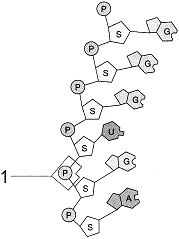The molecular fragment (the G, U and A’s) represented in the accompanying figure is:

a. ATP.
b. RNA.
c. DNA.
d. a nucleotide.
e. a polysaccharide.
b
You might also like to view...
Based on the idea that fungi have pores between their cell walls, which allow cytoplasm to move from one end of the mycelium to the other, which of the following hypotheses is the most plausible?
A) If a single mycorrhizal fungus formed symbiotic associations with more than one tree, carbon could travel from one plant to another. B) Parasitic fungi steal nutrients from their hosts. C) Predatory fungi capture their prey by encircling them with hyphae, and the flowing of the cytoplasm through the pores helps the hyphae to move around the prey. D) Fungi function as part of the global carbon cycle not only by converting carbon from one form to another, but by physically moving it from one location to another.
Identify the structure indicated by the letter “B” in
the internal environment. a. tight junctions b. adhering junctions c. gap junctions d. homeostatic junctions e. none of these
Which does not describe simple squamous epithelium?
Viral growth in bird embryos can cause discrete, opaque spots in the embryonic membranes called
A. cytopathic effects. B. pocks. C. lysogeny. D. budding. E. plaques.